Service for copy trading. Our Algo automatically opens and closes trades.
The L2T Algo provides highly profitable signals with minimal risk.
24/7 cryptocurrency trading. While you sleep, we trade.
10 minute setup with substantial advantages. The manual is provided with the purchase.
79% Success rate. Our outcomes will excite you.
Up to 70 trades per month. There are more than 5 pairs available.
Monthly subscriptions begin at £58.
In order to succeed at online forex trading in the long-run, you will need to have a strategy in place that you know well. No-two strategies are the same – so what works for one trader might not necessarily work for you. With that being said, scalping is one of the most widely used strategies in the online trading space.
In a nutshell, scalping trading is the process of targetting frequent, ultra-small gains throughout the day. The trader will seek to open and close trades with minimal risk, with the view of profiting from ultra-small pricing movements. As such, the trader will likely utilize the 1-minute charts, as they need to have a view of the markets in real-time to scalp successfully.
4
Payment methods
Trading platforms
Regulated by
Support
Min.Deposit
Leverage max
Currency Pairs
Classification
Mobile App
Min.Deposit
$100
Spread min.
Variables pips
Leverage max
100
Currency Pairs
40
Trading platforms
Funding Methods





Regulated by
FCA
What you can trade
Forex
Indices
Actions
Cryptocurrencies
Raw Materials
Average spread
EUR/GBP
-
EUR/USD
-
EUR/JPY
0.3
EUR/CHF
0.2
GBP/USD
0.0
GBP/JPY
0.1
GBP/CHF
0.3
USD/JPY
0.0
USD/CHF
0.2
CHF/JPY
0.3
Additional Fee
Continuous rate
Variables
Conversión
Variables pips
Regulation
Yes
FCA
No
CYSEC
No
ASIC
No
CFTC
No
NFA
No
BAFIN
No
CMA
No
SCB
No
DFSA
No
CBFSAI
No
BVIFSC
No
FSCA
No
FSA
No
FFAJ
No
ADGM
No
FRSA
71% of retail investor accounts lose money when trading CFDs with this provider.
Min.Deposit
$100
Spread min.
- pips
Leverage max
400
Currency Pairs
50
Trading platforms
Funding Methods




Regulated by
CYSECASICCBFSAIBVIFSCFSCAFSAFFAJADGMFRSA
What you can trade
Forex
Indices
Actions
Cryptocurrencies
Raw Materials
Etfs
Average spread
EUR/GBP
1
EUR/USD
0.9
EUR/JPY
1
EUR/CHF
1
GBP/USD
1
GBP/JPY
1
GBP/CHF
1
USD/JPY
1
USD/CHF
1
CHF/JPY
1
Additional Fee
Continuous rate
-
Conversión
- pips
Regulation
No
FCA
Yes
CYSEC
Yes
ASIC
No
CFTC
No
NFA
No
BAFIN
No
CMA
No
SCB
No
DFSA
Yes
CBFSAI
Yes
BVIFSC
Yes
FSCA
Yes
FSA
Yes
FFAJ
Yes
ADGM
Yes
FRSA
71% of retail investor accounts lose money when trading CFDs with this provider.
Min.Deposit
$10
Spread min.
- pips
Leverage max
10
Currency Pairs
60
Trading platforms
Funding Methods

What you can trade
Forex
Indices
Cryptocurrencies
Average spread
EUR/GBP
1
EUR/USD
1
EUR/JPY
1
EUR/CHF
1
GBP/USD
1
GBP/JPY
1
GBP/CHF
1
USD/JPY
1
USD/CHF
1
CHF/JPY
1
Additional Fee
Continuous rate
-
Conversión
- pips
Regulation
No
FCA
No
CYSEC
No
ASIC
No
CFTC
No
NFA
No
BAFIN
No
CMA
No
SCB
No
DFSA
No
CBFSAI
No
BVIFSC
No
FSCA
No
FSA
No
FFAJ
No
ADGM
No
FRSA
Your capital is at risk.
Min.Deposit
$50
Spread min.
- pips
Leverage max
500
Currency Pairs
40
Trading platforms
Funding Methods




What you can trade
Forex
Indices
Actions
Raw Materials
Average spread
EUR/GBP
-
EUR/USD
-
EUR/JPY
-
EUR/CHF
-
GBP/USD
-
GBP/JPY
-
GBP/CHF
-
USD/JPY
-
USD/CHF
-
CHF/JPY
-
Additional Fee
Continuous rate
-
Conversión
- pips
Regulation
No
FCA
No
CYSEC
No
ASIC
No
CFTC
No
NFA
No
BAFIN
No
CMA
No
SCB
No
DFSA
No
CBFSAI
No
BVIFSC
No
FSCA
No
FSA
No
FFAJ
No
ADGM
No
FRSA
71% of retail investor accounts lose money when trading CFDs with this provider.
If you are keen to find out whether or not this particular trading strategy is right for you – be sure to read our guide on What is Scalping Trading? Not only will we give you the ins and outs of what scalping is and how it works, but we will also discuss the best forex brokers to use the strategy at.
Table of Contents
Eightcap - Regulated Platform With Tight Spreads

- Minimum deposit of just 250 USD to get lifetime access to all the VIP channels
- Use our Secure and Encrypted Infrastructure
- Spreads from 0.0 pips on Raw Accounts
- Trade on the Award-Winning MT4 & MT5 Platforms
- Multi-jurisdictional Regulation
- No Commission Trading on Standard Accounts

What is Scalping Trading?
In its most basic form, scalping is a trading strategy that targets small profits, on a frequent basis throughout the day. As such, the trader will rarely keep a trade open for more than a few minutes. This is in stark contrast to a traditional swing trader, which can see traders hold on to positions for a number of days or weeks.
Although scalping trading can be utilized on virtually any asset class, it is most common in the forex space. This is because currency pairs – especially the majors, move on an ultra-small basis around the clock. Moreover, major currency pairs are highly liquid, making them perfect for a scalping trading strategy.

With that said, scalping is often viewed as a low-risk strategy, as traders will install stop-loss orders to keep potential losses to a minimum. In fact, this is crucial. as a sizable loss could wipe out dozens of successful scalping trades that the investor made earlier in the day.
What are the Pros and Cons of Scalping?
The Pros The Cons
How Does Scalping Trading Work?
If you have never performed a scalping trade before, it is probably best that we give you a couple of examples to clear the mist.
🥇 Example 1: Scalping GBP/USD
Let’s say that you are looking to trade GBP/USD with your scalping strategy. Your starting balance is £1,000, and you decide to refrain from leverage.
- GBP/USD is currently priced at 1.3104
- Upon studying the charts, you think that GBP is likely to increase in the next few minutes
- As such, you place a £1,000 buy order
- You place a take-profit order at 1.3169, which amounts to an increase of 65 pips or 0.5%
- You also place a stop-loss order to mitigate your losses. At 1.3077, this would amount to a loss of 27 pips or 0.2%
- GBP/USD hits 1.3169, so your scalping position is automatically closed at a profit of 0.5% or £5.
As you can see from the above example, scalping is only concerned with really small gains. In effect, only one of the two things could have happened in the example given. If the trade was successful, the investor would have made 0.5% profit, which amounted to £5.
Although this sounds like an ultra-small amount of profit to be targeting, it is important to note that the trader would look to repeat the above example dozens, or even hundreds of times throughout the day. Alternatively, if the trade was unsuccessful, the investor would have limited their losses to just 0.2% or £2.
Let’s take a look at a second example to ensure you understand how scalping trading works.
🥇 Example 2: Scalping EUR/USD with Leverage
Although scalping trading is concerned with ultra-small price movements, gains should be viewed in terms of pips or percentages – and not monetary profits per-say. As such, it is entirely feasible for traders to utilize leverage in their search for small pricing movements.

- EUR/USD is currently priced at 1.1389
- The scalping trader thinks that EUR will increase in value against the USD in the next few minutes, so they place a buy order
- The trader always seeks to make 0.3% profit from their trades, so a take-profit order of 1.1423 is executed
- To mitigate their losses to 0.1%, a stop-loss order of 1.1377 is also placed
- The trader also applies leverage of 10:1, taking the total stake from £1,000 to £10,000
- The scalping trade is successful, as EUR/USD hits the target price of 1.1423 a few minutes later
As per the above example, a 0.3% profit on £1,000 amounts to £3. However, as the trader applied leverage at 10:1 on the position, the gains were amplified to £30. On the flip side, if the trade was closed at a loss, this would have taken the loss to £10. As such, each trade that the scalping trader makes will either result in a profit of £30, or a loss of £10. This means that the trader needs to land one successful trade out of every three in order to break even.
Benefits of Scalping Trading
If you have read our guide up to this point, then you will know that scalping trading has a completely different mindset to that of swing trading. In fact, scalping is a lot more controlled and systematic, not least because only one of two outcomes will ever present themselves. On the contrary, swing trading often takes a “let’s see how the markets react” approach.
Here are some of the most notable benefits of scalping trading.
✔️ Less Exposure to Risk
One of the overarching benefits of employing a scalping trading strategy is that you always have a risk mitigation plan in place. This comes in the form of a stop-loss order, meaning that you will never lose more than the exit trigger price.
✔️ Magnitude of Trades
If you have a strong passion for the financial markets, then scalping trading is ideal. This is because you will likely be required to place dozens – if not hundreds of trades per day.
Do not forget, you will only be looking to make a few pips in gains per trade, so you need to be repeating the process throughout the day to make scalping profitable. As such, scalping trading is best suited for those of you that wish to trade on a full-time basis.
✔️ Profit When Markets Consolidate
When a particular asset consolidates – this means that it trades within a certain range for a number of hours or days, before the markets decide which way the asset goes next.
For example, a consolidation period on GBP/USD might see the currency pair trade in a tight range of 1.3001 and 1.3050. This presents highly conducive conditions to scalp trade.
✔️ Huge Number of Trading Opportunities
Scalping trading can be utilized on virtually any asset class. This is especially the case when trading major forex pairs, as the markets operate on a 24/7 basis. Moreover, major pairs benefit from heaps of liquidity, and volatility levels are typically low – making it perfect for scalping.
 ✔️ Avoid the Threats of Greed
✔️ Avoid the Threats of Greed
Greed is often the difference between a trader making consistent gains, and a trader that burns their bankroll through irrational positions. With that said, scalping is only concerned with making ultra-small – albeit, frequent gains throughout the day. This ensures that the trader refrains from making irrational trades, as an effective scalping strategy will always have the required stop-loss and profit-take orders in place.
Scalping Trading Tips
There are a number of considerations that you need to make before getting your scalping trading career started. By following the tips outlined below, you stand the best chance possible of protecting your bankroll from burnout.
🥇 Tip 1: Get Comfortable With the 1-Minute Chart
Those that engage with traditional swing trading will have no interest in the 1-minute charts. This is because swing traders are looking at the longer-term picture, so the 1-minute chart is useless in this respect.
However, the 1-minute chart is a minimum requirement when scalping trading, not least because you will be looking to jump on ultra-small pricing movements. As such, it is crucial that you get comfortable with the 1-minute chart before putting your scalping strategy into practice.
🥇 Tip 2: Niche-Down to Specific Currency Pairs
Scalping trading is not just about the charts. On the contrary, it is about having a firm understanding of what makes a certain currency pair ‘tick’. For example, does the currency pair experience more volatile movements during certain parts of the day? Or, is liquidity somewhat thin on certain days? Either way, these are key metrics that you as a scalping trader need to be aware of.
As such, it is well worth considering niching-down to just a few forex pairs. In doing so, you will have advanced knowledge on a small number of chosen pairs, and thus – give yourself the best chance possible of making more successful trades than losing trades.
🥇 Tip 3: Choose Your Profit and Risk Parameters
Before you even think about placing your first scalping trade, it is crucial that you think about your trading parameters. Firstly, you need to think about how much profit you intend to make per trade. This figure should remain constant at all times to ensure that your scalping becomes a systematic process free from irrationality.
For example, if you decide to target 0.2% in gains per position, this is what your take-profit order should remain at. Similarly, you also need to think about the most you are prepared to lose per trade. Much like your profit-take orders, your stop-loss orders should remain constant.
🥇 Tip 4: You Need a High Win Ratio to Succeed
Traditional swing traders can often get by with a win ratio of less than 50% and still make long-term gains. For example, the investor might lose 5% on three unsuccessful trades, but then make 25% on a trade they kept open for a number of months. However, this luxury is not available to scalping traders.

🥇 Tip 5: You Do not Need to use Leverage to Succeed
There is often a misconception from newbie investors that scalping trading is only worth doing if you apply leverage to your trades. While leverage can amplify your small gains, it can do the same to your losses. With that said, the overarching concept of scalping is to that you want to make small profits across hundreds of trades, so leverage is not a necessity if you have a high win ratio.
For example, let’s say that you are trading with an account balance of £2,000. If your take-profit level was set at 0.2%, this means you would make £2 per successful trade. However, if you were able to place 100 trades per day – and 75% of them were successful, you would be making a decent income – while at the same time building your trading bankroll in a systematic manner.
How do I Choose a Forex Broker for Scalping Trading?
So now that you know the ins and outs of what scalping trading is and how the process typically works, you now need to start thinking about choosing a broker. In order to find the best broker for your trading needs, you need to make a range of considerations to ensure the platform is conducive for scalping.
This should include:
🥇 The Spread
First and foremost, you need to assess the types of spreads that the broker charges. For those unaware, this is the difference between the ‘buy’ and ‘sell’ price of a particular forex pair. For example, let’s say that the buy price on GBP/USD is ‘1.3117’, and the sell price is ‘1.3120’.
With the difference between the two prices set at 3 pips, this means that you will need to make at least 3 pips just to break even. The larger the spread, the more you need to make to get your trade in the green, so it is crucial that you go with a broker that offers tight spreads.
This could not be more important in the case of scalping, as you will be looking to make ultra-small gains. The spreads charged by brokers can vary considerably depending on the type of forex pair you are trading. For example, majors will always come with the tightest spreads – as liquidity and volatility levels are low, and trading volumes are high.
🥇 Trading Commissions
On top of the spread, you also need to make some considerations regarding trading commissions. Once again, this will have a direct impact on your ability to make small gains throughout the day, so you need to explore the underlying fee structure employed by the broker. This is usually charged as a percentage of the trade size and is charged at both ends of the trade.
For example, let’s say that you place a trade worth £2,000, and the broker charges 0.1% in commission. This means that you will need to pay £2 to place the trade. If you then sell the order when it is worth £2,200, you would pay a fee of £2.20. Ultimately, you need to go with a broker that charges low trading commissions.
🥇 Order Execution
While tight spreads and low commissions are equally crucial metrics to look for when choosing a forex broker for scalping – as is the order execution process. This is the amount of time that it typically takes for a forex broker to execute your order from the time it was placed.
You should choose a broker that has the capacity to execute your scalping order in micro-seconds – as this will ensure that you get your order on at the required price. Brokers usually publish this information on their website, alongside the actual process utilized when matching buyers and sellers.
🥇 Advanced Charting Tools
Scalping trading requires high-level research and analysis to succeed. After all, you are looking to predict which way the markets are going to go on almost a minute-by-minute basis. The only way to do this effectively is to have a firm grasp of how advanced charting tools and technical indicators work.

🥇 Regulation
You also need to assess the regulatory standing of your chosen forex broker. At an absolute minimum, the broker should hold a license from a respected financial body. For example, if you are based in the UK. the broker needs to be authorized and regulated by the Financial Conduct Authority (FCA).
On top of the actual license, you should spend some time exploring the broker’s reputation. You can do this by perusing through online reviews that are available in the public domain.
Best Forex Broker for Scalping 2023
By following the above guidelines on how to choose a forex broker for scalping, you will have the required tools to find a platform that best meets your needs. However, if you do not have the time to perform your own due diligence, we have listed our top scalping broker picks below.
1. AVATrade – 2 x $200 Forex Welcome Bonuses (bonus permission is approved by regulation)
The team at AVATrade are now offering a huge 20% forex bonus of up to $10,000. This means that you will need to deposit $50,000 to get the maximum bonus allocation. Take note, you will need to deposit a minimum of $100 to get the bonus, and your account needs to be verified before the funds are credited. In terms of withdrawing the bonus out, you will get $1 for every 0.1 lot that you trade.

- 20% welcome bonus of up to $10,000
- Minimum deposit $100
- Verify your account before the bonus is credited
2. VantageFX – Ultra-Low Spreads
VantageFX VFSC under Section 4 of the Financial Dealers Licensing Act that offers heaps of financial instruments. All in the form of CFDs - this covers shares, indices, and commodities.
Open and trade on a Vantage RAW ECN account to get some of the lowest spreads in the business. Trade on institutional-grade liquidity that is obtained directly from some of the top institutions in the world without any markup being added at our end. No longer the exclusive province of hedge funds, everyone now has access to this liquidity and tight spreads for as little as $0.
Some of the lowest spreads in the market may be found if you decide to open and trade on a Vantage RAW ECN account. Trade using institutional-grade liquidity that is sourced directly from some of the top institutions in the world with zero markup added. This level of liquidity and availability of thin spreads down to zero are no longer the exclusive purview of hedge funds.

Conclusion
If you have read our guide from start to finish, you should now have a really firm understanding of what scalping trading is and how the process typically works. We have broken down the fundamentals of what you need to do to get your scalping trading career off on the right foot. This includes the ability to read the 1-minute charts, and the need to set sensible and consistent stop-loss and profit-take orders. In doing so, you will stand the best chance possible of mitigating your risks.
However, it is also important to remember that you will need to possess a high win ratio to succeed in scalping trading. This is because your profits will be based on ultra-small percentages, so you need to be making a lot of them to make scalping worthwhile. We have also given you a full breakdown of what to look out for when choosing a forex broker to facilitate your scalping trades. On top of low spreads and trading commissions, you also need to choose a broker that has an excellent track-record in executing orders in microseconds.
AvaTrade - Established Broker With Commission-Free Trades

- Minimum deposit of just 250 USD to get lifetime access to all the VIP channels
- Awarded Best Global MT4 Forex Broker
- Pay 0% on all CFD instruments
- Thousands of CFD assets to trade
- Leverage facilities available
- Instantly deposit funds with a debit/credit card

FAQs
What is scalping trading?
Scalping is a trading strategy that sees the investor 'scalp' ultra-small gains. These gains will often amount to a few pips per position, albeit, scalpers typically place more than 100 trades per day. As such, it is hoped that these small gains will transition into heaps of profitable trades throughout the day.
Do I need to set up stop-loss orders when scalping trading?
The utilization of stop-loss orders is a minimum requirement when scalping trading. This is because the strategy seeks to trade in a super low-risk manner, with losses kept to a minimum. This is important, as scalping trading requires a much higher win ration in comparison to swing trading.
What is the difference between scalping and swing trading?
Swing trading might see the investor keep a position open for a number of days, weeks, or even months. On the contrary, swing traders will rarely keep a position open for more than a few minutes.
How much should I target in gains when scalping trading?
There is no one-size-fits-all answer to his question, as no-two traders are the same. The most important thing to look at is the size of your take-profit order in relation to your stop-loss orders. You need to get the balance right to ensure you protect your bankroll.
What is the best asset class for scalping trading?
Forex is often highly conducive for scalping trading - especially the majors. This is because major currency pairs benefit from high liquidity, low volatility, and the markets operate 24/7.
Do I need to apply leverage when scalping trading?
You are not required to apply leverage to make scalping worthwhile. Although you will only be targeting super-low gains, it is hoped that you are able to place dozens of successful trades per day.
How much should I start with when scalping trading?
If you have little to no experience of scalping trading, we would suggest keeping your stakes to really small amounts. You will likely make mistakes when you first get started, so it is best to avoid risking too much until you get more comfortable with scalping.



 ✔️ Avoid the Threats of Greed
✔️ Avoid the Threats of Greed